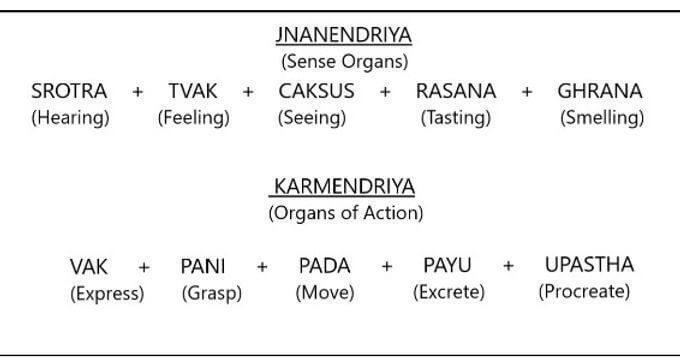Author: Randeep Singh / go to all Samkhya Karikas

Samkhya Karika 26 text:
Buddhi indriyani caksuh srotram grahana rasana tvak akhyani |
Vak pani pada payu upasthah karmendriyani ahuh ||
Buddhi indriyani – senses of perception, Jnanendriyas
Caksuh – eyes
Srotram – ears
Grahana – nose
Rasana – tongue
Tvak – skin
Akhyani – are known as
Vak – speech
Pani – hands
Pada – feet / legs
Payu – organs of excretion
Upasthah – organs of reproduction
Karmendriyas – organs of action, powers of action
Ahuh – they reveal, say, or mention
Samkhya Karika 26 explains that from Sattvik Ahamkara (aided by rajas) evolve ten sense faculties (organs). Though mind – the eleventh sense organ – also evolves from the Saatvik Ahamkara it is separately elaborated upon in the next karika. These sense organs of perception are also known as Buddhi indriyas because they are the instruments of the Buddhi (Intellect) through which it perceives, or knows the material universe present around the being. Sense faculties – made of Prakriti – are the extensions of Purusha into the material universe which also evolve from Prakriti, via Buddhi and then Ahamkara – level at which separate individual identity begins to emerge due to its self-limiting influence, that is the reason that the sense organs are present at the individual level.
Sattvik Ahamkara – 5 Jnanedriyas and 5 Karmendriyas
Indra means Purusha, or soul, indriya means the instruments of Indra (Purusha) for gaining knowledge of the material universe the individual entity which the Purusha pervades exists in. Atma, or soul experiences the knowledge it receives from its extensions into the world, the sense organs, or the Indriyas. This Samkhya Karika classifies the Indriyas into two categories: Buddhi indriyas (organs of Perception) and Karma Indriyas (organs of action).
Buddhi Indriyas
- Caksu – organ of perception of sight – eyes
- Srotram – organ of perception of hearing – ears
- Grahana – organ of perception of smell – nose
- Rasana – organ of perception of taste – tongue
- Tvak – Organ of perception of touch – skin
Without these five faculties of perception the world around oneself cannot be known or carries any relevance. Knowledge is gained when each sense of perception comes in contact with its object, or sense object. This knowledge is received by the mind and filters by the buddhi (intellect). But the final entity which interprets and experiences it is the Purusha, or the soul (Indra). Thus, it’s the Purusha for the use of which the sense organs collect the knowledge from the sense objects.
Karma Indriyas
Karma indriyas are the organs which enable function and movement of the conscious entity and are crucial to imparting deeper and fuller experiences of the world to it. These are also five in number.
- Vak – organ of action of speech – speech organs
- Pani – organ of action of grasp, hold – hands
- Pada – organ of action of movement – legs, feet
- Payu – organ of action of excretion – anus
- Upasthah – organ of action of reproduction – reproductive organs
Sense Organs can give Enjoyment or Liberation | Samkhya Karika 26
“Modern Times” was a movie made by the famous comedian, Charlie Chaplin. It was a witticism on the modern way of a mechanical life, following the industrial revolution. A man stands before a machine, machine starts working and takes complete hold of him. He is force fed whether he likes it or not. He gets baffled and runs away. The machine does not remain a tool of the man but becomes his master.
The present world is just like this. We enter a mall to buy a particular thing, but end up shopping many more items, which we actually do not need. Something of this sort happens in whatever we do. We get drawn and connected to the objects through our senses. Eyes see, hands grab and whatever mind thinks become real. All this is done by Prakriti. We should be aware of this play of Prakriti and though we witness it we should not forget the Divine consciousness, the Purusha.
There is a story of Gautama Buddha. The young prince observes, sickness, old age and death. By seeing thus and contemplating on this, Prince Siddhartha becomes the Buddha.
All is borne out of Prakriti. The state of Prakriti keeps changing. We are surrounded by material things. We will have to always bear in mind as to who is the master and who is the servant. Let us use things for sure, but in right manner. Only intelligence is pure; all the other evolutes of Prakriti, takes us down to the gross world. Presently, multi cuisines have become so popular that since the time we get up, we find ourselves encircled by such stuff. Just earn money and squander it away has become the meaning and purpose of life today. It is important for us to contemplate on the futility of such thoughts and actions and work on increasing our awareness of consciousness.
Yoga has developed certain techniques for keeping the Jnanendriyas and karmendriyas in their optimal physical, functional state so that they can be used by the practitioner for gaining the right knowledge in order to relaize the consciousness. Yoga techniques for some of these sense organs can be accessed form here.
Yoga Techniques for Jnanendriya’s health:
